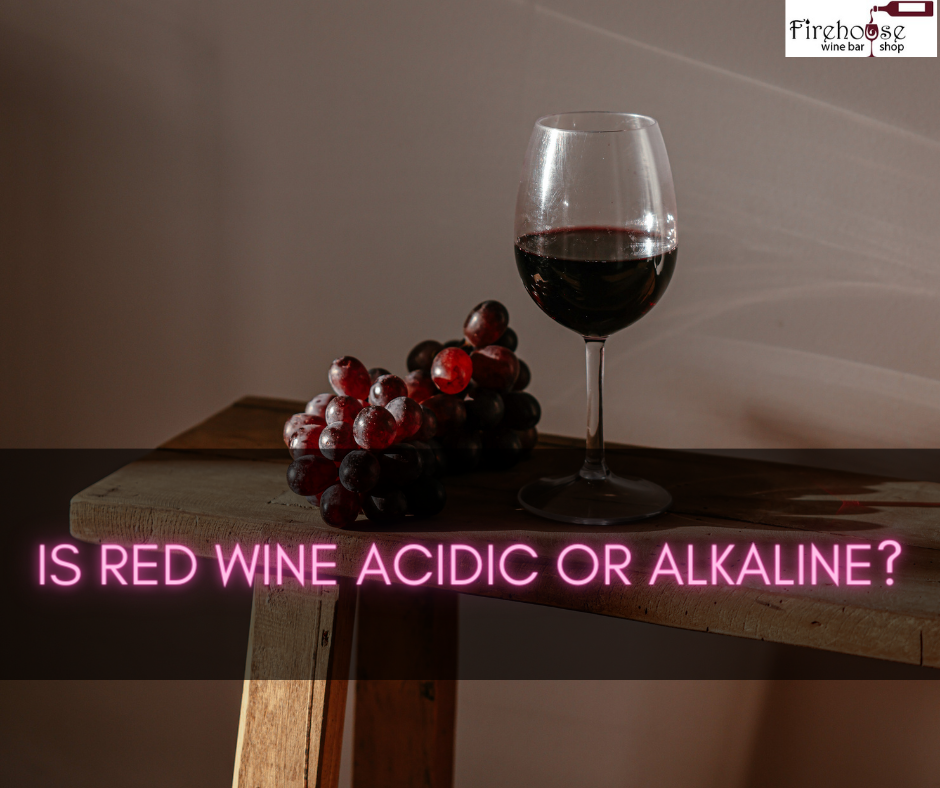Introduction
Red wine is popular among enthusiasts due to its rich flavors and aromas. One common question that arises is whether red wine is acidic or alkaline. Understanding the pH levels of red wine can provide insight into its taste and characteristics. In this blog section, we will investigate the pH levels of red wine and explore the factors contributing to its acidity to answer ‘Is Red Wine Acidic or Alkaline?‘.
The Acidic Taste Of Red Wine
When we talk about acidity in wine, we are referring to the tart and sour taste that it imparts. All wines generally fall on the acidic side of the pH spectrum, with most red wines ranging from 3.5 to 3.8 on the pH scale. The tartaric and malic acids found naturally in grapes contribute to the acidity of red wine. These acids play a vital role in balancing the flavors and preserving the stability of the wine. However, it is important to note that not all red wines have the same level of acidity. The acidity of red wine can vary depending on factors such as grape variety, climate, and winemaking techniques.

The Importance Of pH Levels In Wine
The pH level of wine is a crucial factor that affects its taste and quality. pH measures the acidity or alkalinity of a solution, and in the case of wine, it signifies the presence of acids. Wine pH levels range from 2.9 to 3.9, with lower values indicating higher acid levels. The pH level of wine influences its taste and plays a role in its stability and aging potential. Wines with higher acidity levels and lower pH values are more stable, as the acidic environment discourages the growth of bacteria and other unwanted microorganisms. On the other hand, wines with lower acidity levels and higher pH values can develop a softer and rounder mouthfeel.
To give you a better understanding, here is a table comparing the pH levels of several popular red wines:
| Red Wine | pH Level |
|---|---|
| Cabernet Sauvignon | 3.5-3.8 |
| Merlot | 3.3-3.6 |
| Pinot Noir | 3.4-3.6 |
| Syrah/Shiraz | 3.4-3.7 |
| Malbec | 3.3-3.6 |
It is important to note that the pH scale is logarithmic, meaning that each whole number change represents a tenfold difference in acidity. Therefore, a wine with a pH level of 3 is ten times more acidic than a wine with a pH of 4.
In conclusion, red wine is characterized by its acidity, which gives it its tart and sour taste. The pH levels of red wine play a significant role in determining its taste, stability, and aging potential. Understanding the acidity of red wine can help you select the perfect bottle to suit your preferences. So whether you prefer a crisp and tart red or a softer and rounder one, a wide range of options are available to satisfy your palate.
Understanding Acidity In Red Wine
Red wine is often associated with richness and bold flavors, but have you ever wondered about its acidity? Acid is one of the fundamental components of wine that contributes to its taste and structure. In this blog section, we will delve into the pH levels of red wine and explore the factors that influence acidity.
Factors Affecting Acidity In Wine
Various factors influence red wine’s acidity, including grape variety, climate, and winemaking techniques. Grapes grown in cooler climates tend to have higher acidity levels than those grown in warmer regions. The grapes’ ripeness also influences red wine’s acidity at the time of harvest. Riper grapes have lower levels of acidity compared to their less ripe counterparts.
Winemaking techniques can further impact acidity. For example, some winemakers undergo malolactic fermentation, where malic acid (a type of acid found in grapes) is converted into lactic acid. This can result in a smoother and less acidic taste.
Types Of Acids Found In Red Wine
Red wine contains various acids, with the most prevalent tartaric and malic acids. Tartaric acid is the primary acid found in wine grapes and is crucial in stabilizing a wine’s color and flavor profile. Malic acid, on the other hand, contributes to a young fruit flavor commonly associated with red wines.
Other types of acids found in red wine include citric acid and lactic acid. Citric acid is in smaller quantities and often added to wines after fermentation. Lactic acid is the primary acid in fermented products and provides a creamier mouthfeel when present in wine.
Red wine is generally considered acidic, with average pH levels ranging from 3.5 to 3.8. The acidity of red wine contributes to its overall taste profile and can vary depending on grape variety, climate, and winemaking techniques.
Understanding the acidity of red wine can help you appreciate its flavors and make informed decisions when pairing it with food. So, the next time you indulge in a glass of red wine, take a moment to appreciate its acidity and its role in enhancing your tasting experience.
Ph Levels In Red Wine
Red wine lovers often wonder about the acidity of their favorite drink. pH levels play a crucial role in the taste and quality of wine, including its color, oxidation, and chemical stability. In this blog section, we will investigate the pH levels of red wine to determine ‘Red wine is acidic or Alkaline?’.
Measuring Ph In Red Wine
pH is a measure of the acidity or alkalinity of a substance. It is measured on a scale of 0 to 14, with values below 7 indicating acidity and above 7 indicating alkalinity. The pH of red wine is an important factor in winemaking as it affects the wine’s sensory properties, chemical reactions, and overall stability.
To determine the pH level of red wine, oenologists and winemakers use different methods, such as pH meters and test strips. pH meters use the potential created by the difference in hydrogen ion concentration on both sides of a glass membrane. On the other hand, test strips are paper strips infused with chemicals that change color based on the pH level of the liquid.
Average Ph Levels In Different Types Of Red Wine
The pH levels in red wine can vary depending on several factors, including grape variety, ripeness, climate, and winemaking techniques. On average, red wines have pH levels between 3.5 and 3.8. It is important to note that pH levels below seven are considered acidic.
Here’s a table showcasing the average pH levels in different types of red wine:
| Red Wine Type | Average pH Level |
|---|---|
| Cabernet Sauvignon | 3.5-3.8 |
| Merlot | 3.5-3.8 |
| Pinot Noir | 3.4-3.6 |
| Syrah/Shiraz | 3.5-3.8 |
| Malbec | 3.5-3.8 |
It is worth mentioning that pH levels can vary within each red wine type. Factors such as region, climate, and winemaking practices influence the final pH of the wine.
While red wine is typically considered acidic due to its pH levels below 7, the overall taste and perception of acidity may vary. Winemakers strive for a well-balanced wine that combines acidity with other flavor components to create a harmonious taste experience.
In conclusion, red wine is generally acidic, with a pH between 3.5 and 3.8. The acidity of red wine contributes to its sensory properties and overall quality. However, the perception of acidity can be influenced by other flavor elements in the wine, resulting in a balanced and enjoyable drinking experience.

Is Red Wine Acidic Or Alkaline? – Investigating The Ph Levels Of Red Wine
Regarding wine, acidity plays a crucial role in determining its flavor, structure, and overall quality. But is red wine acidic or alkaline? Let’s take a closer look at the pH levels of red wine to understand its acidity.
The Effects Of Acidity In Red Wine
Acidity is an important component in wine that contributes to its taste profile. The acidity of red wine is measured on a pH scale, with lower pH numbers indicating higher acid levels. On average, red wines have pH levels ranging from 3.5 to 3.8. This indicates that red wine tends to be acidic.
The acidity in red wine is mainly derived from two acids naturally present in grapes: tartaric acid and malic acid. These acids contribute to the overall flavor and balance of the wine. Higher acidity in red wine can make it taste crisper and tart on the palate. It creates a refreshing sensation, making your mouth water and pucker up.
In contrast, lower-acid red wines feel smoother and rounder on the palate. This can create a more mellow and less pronounced taste experience. However, when the acidity in red wine is too low, it can result in a flabby or almost soapy feeling.
How Acidity Affects The Flavor And Structure Of Red Wine
The acidity in red wine also contributes to its color and stability. Wines with higher acidity typically have a bright ruby color, thanks to the lower pH levels that give them a red hue. On the other hand, less acidic red wines may take on a blue or purple hue.
Acidity in red wine also plays a role in its aging potential. Wines with higher acidity tend to improve with time and develop more complex flavors. The stability of high acid/low pH wines helps during the aging process. In contrast, red wines with high pH levels are more prone to contamination, affecting their appearance and taste.
The Role Of Acidity In Wine Pairings
The acidity in red wine also affects its compatibility with different types of food. Higher-acid red wines pair well with dishes with rich and fatty flavors. The acidity helps cut through the richness and balances the overall taste. On the other hand, low-acid red wines are better suited for milder dishes to avoid overpowering their flavors.
Understanding red wine’s acidity is essential for wine enthusiasts and sommeliers. It provides valuable insights into a particular red wine’s taste profile, aging potential, and food-pairing options.
As you explore the fascinating world of red wine, please pay attention to the acidity levels and how they influence your enjoyment of different varietals. Remember, each wine has unique characteristics, and finding the right balance of acidity is crucial to experiencing its full potential. So, the next time you enjoy a glass of red wine, savor its acidity and appreciate the complex flavors it brings to your palate.
Alkalinity In Red Wine
Debunking The Alkaline Wine Myth
The debate over whether red wine is acidic or alkaline has been among wine enthusiasts for years. Some people claim that red wine is alkaline, while others believe it to be acidic. So, what is the truth? Let’s investigate the pH levels of red wine to uncover the facts.
Contrary to popular belief, red wine is indeed acidic. The average pH levels for red wines range from 3.5 to 3.8, indicating its acidic nature. The primary acid in red wine is tartaric acid, although malic, lactic, and citric acids may also be present. These acids contribute to the characteristic flavors and overall quality of the wine.
The Influence Of Alkalinity On Wine Characteristics
While red wine is acidic, external factors can influence its alkalinity. For instance, potassium found in the soil can make its way into the grapes and increase alkalinity levels. This increase in alkalinity helps neutralize the wine’s acidity and raises its pH.
However, it’s important to note that the influence of alkalinity on wine characteristics is not significant. The acidity of red wine plays a crucial role in determining its flavor profile and overall quality. Wines with higher acidity levels tend to be more vibrant, fresh, and lively on the palate. On the other hand, wines with lower acidity may have a smoother, mellow flavor.
To maintain the desired level of acidity in red wine, winemakers carefully control the presence of acids during the winemaking process. The pH level of the wine is measured, and adjustments can be made accordingly. Tartaric acid is often added to increase acidity, while other methods can be employed to reduce acidity if necessary.
Overall, it’s clear that red wine is acidic rather than alkaline. The acidity of red wine contributes to its unique flavors and plays a significant role in the winemaking process. So, the next time you enjoy a glass of red wine, savor its tangy acidity and appreciate the craftsmanship behind its production.
Stay tuned for the next section, where we will explore the benefits of an acidic or alkaline diet and determine which one is best for you!
Finding The Right Balance
When it comes to enjoying a glass of red wine, acidity plays a significant role in the overall taste and quality of the beverage. The acidity of red wine is determined by its pH level, which measures the acid concentration in a liquid. The pH scale ranges from 0 to 14, with lower numbers indicating higher acidity and higher numbers indicating alkalinity. So, is red wine acidic or alkaline? Let’s investigate the pH levels of red wine to find out.
The Importance Of Balanced Acidity In Red Wine
Acidity is a crucial component in winemaking as it affects the flavor profile and structure of the wine. A red wine can taste flat and dull without the right balance of acidity. On the other hand, excessive acidity can make the wine taste sharp and unpleasant. A well-balanced red wine has an acidity that complements the other elements, such as tannins and fruit flavors, creating a harmonious and enjoyable drinking experience.
The pH levels of red wine typically range between 3.5 and 3.8. Wines with lower pH levels tend to have a higher acidity, resulting in a bright, ruby color and a vibrant taste. These wines often exhibit crisp and tart flavors, making them refreshing and food-friendly. On the other end of the spectrum, red wines with higher pH levels are less acidic and may have a more mellow and softer character.
To illustrate the pH levels of different red wines, here is a comparison:
| Red Wine Type | pH Level |
|---|---|
| High-acidity red wines | <3.5 |
| Well-balanced red wines | 3.5-3.8 |
| Less-acidic red wines | >3.8 |
It’s important to note that individual preferences for acidity can vary. Some wine drinkers enjoy the brightness and tanginess of high-acidity red wines, while others prefer the smoother and less acidic characteristics of well-balanced or less-acidic red wines. It ultimately comes down to personal taste and the food pairing.
Tips For Choosing Red Wines With The Desired Ph Levels
If you prefer red wines with higher acidity, look for wines from grapes grown in cooler climates. These regions tend to produce grapes with higher natural acidity. Examples include Pinot Noir from cooler regions like Burgundy or Oregon.
On the other hand, if you prefer red wines with lower acidity, wines from warmer climates might be more suitable. These regions tend to produce riper grapes with lower acidity levels. Red wines like Syrah/Shiraz from regions like California or Australia might be more to your preference.
Exploring wines from different regions and grape varieties will allow you to discover the acidity levels you enjoy the most. Remember that acidity is just one element of a wine’s overall profile, and finding the right balance that suits your taste buds is essential.
In conclusion, red wine is acidic, but the acidity levels can vary. Finding the right balance of acidity is key to enjoying a delicious glass of red wine. Whether you prefer high-acidity wines or less-acidic options, there is a red wine out there to suit every palate. So, grab a bottle, and cheers to finding the perfect balance for your taste!

The Health Implications Of Red Wine Acidity
The Relationship Between Wine Acidity And GERD Symptoms
Red wine, like many other wines, is known to be acidic. The pH level of red wines typically falls between 3.5 and 3.8, indicating its acidic nature. The acid in wine comes from the grapes used to make it. However, the actual acidity level of a wine can vary based on several factors, including grape variety, climate, and winemaking techniques.
For individuals who suffer from gastroesophageal reflux disease (GERD), the acidity of red wine can potentially trigger symptoms. GERD is when stomach acid flows back into the esophagus, causing discomfort and heartburn. The high acidity of red wine may exacerbate these symptoms in some individuals.
Moderate Red Wine Consumption And Health Benefits
While red wine is acidic, it also contains antioxidants linked to potential health benefits when consumed in moderation. Some studies suggest that moderate red wine consumption, as part of a balanced diet, may positively affect heart health and longevity.
The antioxidants found in red wine, such as resveratrol and other polyphenols, have reduced cardiovascular disease risk. These compounds have been shown to have anti-inflammatory properties and may help protect against certain chronic conditions.
It is important to note that moderation is key in red wine consumption. Excessive alcohol intake can harm health, and the benefits associated with red wine are limited to moderate consumption.
To protect dental health, it is recommended to rinse the mouth with water after consuming acidic beverages like red wine. This can help minimize acid contact with tooth enamel and reduce the risk of enamel erosion.
In summary, red wine is acidic, but moderate consumption and a healthy lifestyle may offer potential health benefits. It’s important to consider individual tolerance and consult with a healthcare professional, especially for those with specific health conditions like GERD. As with any dietary choice, enjoying red wine responsibly and in moderation is crucial.
FAQ about Is Red Wine Acidic or Alkaline? Investigating the pH Levels of Red Wine
Q: What is the pH scale, and how does it relate to wine acidity?
A: The pH scale ranges from 0 to 14 and measures the acidity or alkalinity of a substance. In the context of red wine, lower pH numbers indicate higher acidity levels, while higher pH numbers indicate more alkaline or basic properties.
Q: Does the pH of red wine affect its quality?
A: Yes, the management of acidity and pH levels in winemaking is crucial, as it ultimately determines the quality of the wine. However, it’s important to note that pH alone isn’t the sole factor in defining a wine’s character and freshness. Other elements, such as individual physiology and perception of flavors, also play a role.
Q: How does pH affect the solubility of anthocyanins in red wine?
A: Anthocyanins are the pigments responsible for the red color in red wine. Studies have shown that as the pH of wine increases from 3 to 4, the solubility of anthocyanins decreases. This means that wines with higher pH values may have a lower concentration of these pigments.
Q: Are red wines generally more acidic or alkaline?
A: Red wines typically have a pH range of 3 to 4, which means they lean towards the acidic side on the pH scale. This acidity adds brightness and liveliness to the wine, balancing the flavors and enhancing its overall structure.
Q: How does climate change impact red wine’s acidity and pH levels?
A: The increasing temperatures associated with climate change have been affecting grape acidity by reducing it. Consequently, this leads to an increase in the pH levels of red wine. Winemakers have been facing the challenge of adapting to these changing conditions to preserve their wines’ desired acidity.
Q: How does red wine compare to other acidic beverages?
A: Red wine falls within the acidic range of the pH scale, typically between 3 and 4. In comparison, lemon juice usually has a pH between 2 and 3, while orange juice and some wines are generally between 3 and 4. However, it’s worth noting that individual wine varietals can have slightly different pH levels.
Q: Why is understanding the pH of red wine important?
A: Determining pH’s impact on producing high-quality wines is an urgent matter. By studying the pH levels and acidity, winemakers can ensure that their wines maintain the desired balance, flavor profiles, and longevity.
Q: How can acidity be perceived differently among individuals?
A: Individual physiology can influence the perception of acidity in wine. Factors such as the protein content in saliva can affect how acidic flavors are perceived. Thus, two people can have different experiences of perceived acidity even when tasting wines with the same pH levels.
Conclusion
Understanding The Ph Levels Of Red Wine
Now you should know the answer to ‘Is Red Wine Acidic or Alkaline?’. Regarding the acidity of red wine, it is important to understand that all wines, including red wines, lie on the acidic side of the pH spectrum. Most red wines have pH levels between 3.5 and 3.8, making them slightly acidic. The key factor contributing to red wine’s acidity is the presence of various acids, such as tartaric acid, malic acid, citric acid, and lactic acid.
Tartaric and malic acids are red wine’s primary acids, accounting for about 90% of the total acidity. These acids are crucial in stabilizing a wine’s color and flavor profile. Citric acid has a minor presence in red wine, while lactic acid is often added to enhance the creaminess and complexity of the wine.
The acidity of red wine can vary depending on several factors. The climate in which the grapes are grown, the ripeness of the grapes, and the winemaking process can all influence the final acidity levels. Additionally, wines from cooler climates tend to have higher acidity levels than those from warmer climates.
Enjoying Red Wine In Moderation
While red wine is slightly acidic, it is important to note that moderate consumption of red wine can still be enjoyed as part of a healthy lifestyle. Red wine is known for its potential health benefits, thanks to the presence of antioxidants, such as resveratrol, anthocyanins, and catechins. These antioxidants have been linked to protecting cardiovascular health and reducing the risk of certain chronic diseases.
It is recommended to enjoy red wine in moderation, as excessive alcohol consumption can have negative effects on overall health. Moderation is typically defined as one drink per day for women and up to two per day for men.
In conclusion, red wine is slightly acidic, with pH levels ranging from 3.5 to 3.8. The presence of various acids contributes to the overall acidity of red wine. Understanding the acidity levels can help wine enthusiasts appreciate the nuances of different red wines and make informed choices when selecting their preferred options. Remember, moderation is key when enjoying any alcoholic beverage, including red wine.
References:

Andre Lotz immigrated to the United States from South Africa almost 20 years ago. Still, he didn’t feel truly at home until he settled in Mobile—a city that reminds him of his childhood home of Fish Hoek on the southern cape of Africa.

